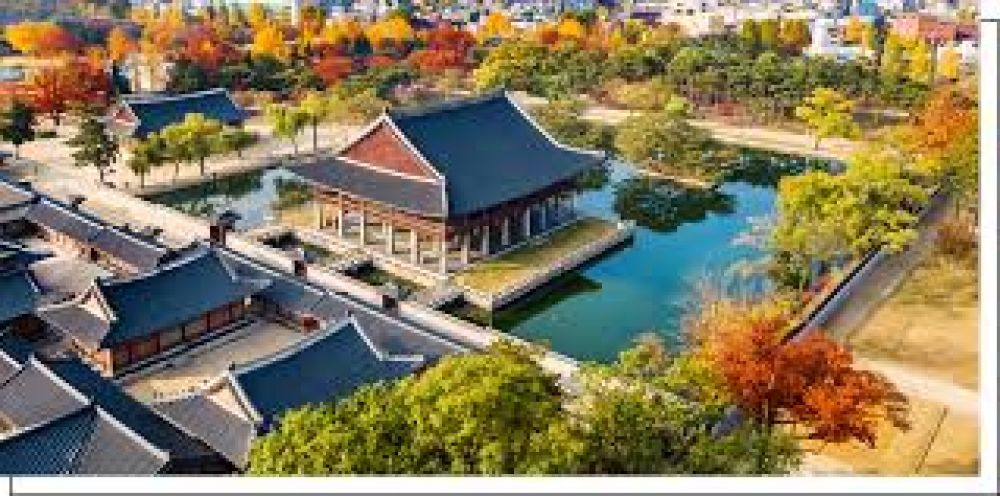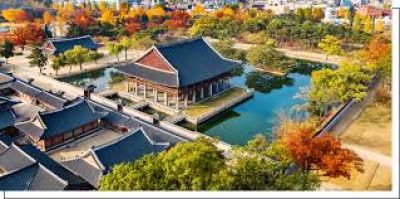

Gyeongbokgung Palace, originally built in 1395, is the largest of the Five Grand Palaces that were constructed during the Joseon Dynasty. A guided tour of this historical site offers an in-depth look into the storied past of Korea. Visitors can marvel at the grandeur of its architecture and the intricate beauty of its roofs and eaves. The tour encompasses the Geunjeongjeon Hall, the throne hall where the king granted audiences to his officials, and Gyeonghoeru Pavilion, where banquets were held. While traversing the expansive grounds, tourists can witness the changing of the guard ceremony, which is a reenactment of the royal guards' patrol routine, complete with traditional uniforms and weaponry. The knowledgeable guides tell tales of the palace's history, including stories of its destruction and meticulous restoration, providing context to the silent walls and bringing the vibrant history of the Joseon era to life.
One of the most picturesque activities at Gyeongbokgung Palace is the Royal Guard Changing Ceremony. This vivid and grand reenactment of the original ceremony dates back to the Joseon Dynasty and takes place at the main gate of the Palace. Visitors are treated to a spectacle of guards in colorful, authentic uniforms, carrying traditional weapons, and playing musical instruments. The ceremony involves detailed maneuvers, the exchange of guard duties, and the inspection of weapons, providing a window into the daily routines of the historical royal guards. The reenactment not only offers a fantastic photo opportunity but also provides a glimpse into the traditions and military practices of ancient Korea. This unique experience allows visitors to step back in time and witness a well-preserved slice of Korean culture and heritage.
Located on the grounds of Gyeongbokgung Palace, the National Palace Museum of Korea is dedicated to the history and culture of the Joseon Dynasty. The museum's exhibitions display a vast array of artifacts, including royal regalia, costumes, furniture, and ceremonial items. Visitors can learn about the lifestyle of the royal family, the social structure of the dynasty, as well as the arts and culture that flourished during the period. The museum offers a comprehensive understanding of Korea's ancestral heritage, with detailed models of the palaces, interactive exhibits, and descriptive panels in multiple languages. A visit here is a deep dive into the country's rich past and a perfect complement to the tour of the palace grounds, allowing historical enthusiasts to immerse themselves in the regal life of old Korea.
Situated within the Gyeongbokgung Palace complex, the National Folk Museum of Korea provides an extensive overview of Korean folk history with a collection of over 4,000 historical artifacts. The museum presents three main exhibition halls, each featuring different aspects of Korean life and culture. From ancient Korean lifestyles, including farming and fishing techniques, to traditional life ceremonies such as weddings and festivals, the Folk Museum encapsulates the daily experiences of Korean people throughout history. Additionally, the museum offers hands-on programs and seasonal events where visitors can engage in traditional Korean crafts and games. The cultural experience at the National Folk Museum is both educational and entertaining, ideal for history buffs and families alike.
For an immersive cultural experience, visitors to Gyeongbokgung Palace can rent traditional Korean attire called 'Hanbok.' Donning these beautiful, vibrant garments, guests can stroll through the ancient palace grounds, feeling as though they have been transported back to the Joseon Dynasty. The intricate designs and fabrics of the Hanbok exemplify the elegance and prominence of Korea's sartorial history. Many rental shops around the palace offer a wide range of Hanbok styles for all sizes and ages, as well as accessories to complete the look. This activity is not only popular among tourists but also offers an excellent opportunity for a unique photoshoot against the backdrop of the palace's charming architecture and lovely gardens, creating memorable moments and stunning photographs.
Hyangwonjeong Pavilion is perhaps one of the most serene and picturesque spots within Gyeongbokgung Palace. This two-story hexagonal pavilion stands on an artificial island in the middle of a tranquil pond, connected to the palace grounds by a charming wooden bridge. Originally built for the relaxation and entertainment of the royal family, the pavilion is surrounded by nature, making it a perfect place for contemplation and photography. The traditional architectural features of Hyangwonjeong Pavilion, combined with the peaceful surroundings, provide a profound sense of harmony and tranquility. Visitors can take a leisurely walk around the pond, enjoy the reflections on the water, and capture the delicate balance of Korean landscape design.
Gyeongbokgung Palace often serves as a venue for Gugak, traditional Korean music performances. These events typically take place in the courtyard or inside one of the pavilions, offering a blend of music, dance, and sometimes even dramatic storytelling. Gugak performances include the use of traditional Korean instruments such as gayageum, geomungo, and daegeum, which create a unique sound that resonates with Korea's past. The performances can range from folk tunes to royal court music, providing a vibrant auditory experience for visitors. Witnessing a live Gugak performance allows guests to connect with Korea's cultural heritage and enjoy an art form that has been handed down through generations.
Jagyeongjeon Hall, one of the living quarters at Gyeongbokgung Palace, offers visitors the unique opportunity to experience a traditional Korean tea ceremony. This cultural activity involves the ceremonial preparation and presentation of tea, accompanied by an explanation of the significance and etiquette surrounding the practice. Participants can learn about the different types of Korean tea, the process of brewing it properly, and the customs of serving and receiving the tea with grace and respect. The tearoom's atmospheric setting within the historical grounds adds to the authenticity of the experience, providing a peaceful escape and a hands-on lesson in Korean traditions.
The Palace Moonlight Tour at Gyeongbokgung is a special nocturnal event that takes place on select dates throughout the year. During this event, visitors can explore the grandeur of the palace under the soft glow of the moon and lantern light, creating a magical atmosphere unlike the daytime experience. The evening ambiance sets a mystical backdrop for exploring the various halls, pavilions, and gardens of the palace. The Moonlight Tour usually includes additional cultural performances, making the night even more enchanting. It's an extraordinary way to experience the palace, as the night setting brings a different perspective to the historical significance and beauty of this ancient royal residence.
The Lotus Lantern Festival, also known as Yeondeunghoe, is a colorful and joyous event that takes place in Seoul, coinciding with Buddha's birthday. While the main events occur throughout the city, Gyeongbokgung Palace often participates with its own lantern displays and celebrations. Visitors can enjoy the sight of thousands of lanterns illuminating the palace, with some shaped like dragons, pagodas, or flowers, symbolizing enlightenment and good fortune. The festival also includes a variety of cultural activities, such as lantern-making workshops, traditional games, and performances. Experiencing the Lotus Lantern Festival at the palace offers a chance to partake in one of Korea's most significant cultural and spiritual observances.
